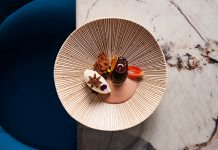Sticky Rice Cake (Nian Gao). Photo: Joseph Fraude
By Lauren Tan (Lauren’s Kitchen)
For many Chinese households, Lunar New Year would be amiss without the traditional Sticky Rice Cake – Nian Gao. Make it from scratch using this simplified fail-proof recipe that Lauren refined based on her grandma’s version.
Total time: 4 hours
Difficulty: 2/5
Cost: $3
Servings: 2 cakes
 A: Cake Batter
A: Cake Batter
500g glutinous rice flour
500g granulated sugar
550ml water, room temperature
B: Steaming
2-3 litres water, fill water until it reaches steaming rack
C: Lining Cake Pans
2-3 banana leaves, washed
2 cake pans (12cm diameter x 7.5cm height)
1 tablespoon cooking oil
DIRECTIONS:
1. In a large saucepan, boil 1 litre water over high heat. Soften banana leaves by blanching them in boiling water for a few minutes. Cut 4 layers of banana leaf squares to double-line sides of cake pans twice. Trace circumference of cake base and cut 2 pieces of banana leaves. Press leaves over cake base. Trim any excess leaves. Secure banana leaf with a thick rubber band tied around the circumference.
2. In a small saucepan, cook sugar over low heat. When the bottom layer of sugar starts to melt, it will caramelise. Stir with a large spoon until the syrup becomes evenly brown. Then allow it to cook until it begins to boil and melt, approximately 5-10 minutes. Stir gently all the time.
3. Pour in water slowly while stirring continually with a large spoon. The golden brown sugar starts to solidify once it comes in contact with water. Continue cooking until sugar is fully dissolved. Set aside to cool at room temperature.
4. In a large mixing bowl, sift glutinous rice flour into it. Make a well in the centre. Slowly pour in caramel, stirring all the time with a whisk. Sieve batter using a stainless steel sieve, then cover with cling film. Let it rest approximately 30 minutes.
5. Using a pastry brush, brush banana leaf with some oil so that the sticky batter will not adhere to the banana leaf. The batter expands while it steams, so fill it to 2/3 otherwise it will overflow. Cover cakes with aluminium foil to prevent condensation from forming on surface of the batter.
6. Steam cakes on high heat for 30 minutes in a wok. After that, lower heat to medium. Continue steaming another 2.5 hours until it becomes toasty brown. Check water level periodically and top it up if needed. Remove from heat and discard foil. Let cakes cool completely at room temperature. It takes 3 days for cake texture to firm up before it can be cut. After 3 days, wrap each cake individually, pop them into the fridge, where it can last up to 2 months.
7. To serve, enjoy it freshly steamed in its molten stage – neat or with freshly grated coconut. Alternatively, panfry nian gao slices coated in beaten egg till crisp but still gooey inside.
TIP: Lining cake pans with banana leaf prevents the batter from leaking into the base while steaming. As water in the wok evaporates, pour in more hot water – this helps to maintain a high internal temperature for cakes to set evenly.
TECHNIQUE: When making caramel, always start on low heat. The bottom layer of sugar in direct contact with cake pan will start to caramelise first. Keep an eye on it at all times. Do not let it burn as burnt sugar tastes bitter.
LAUREN’S KITCHEN: The kitchen has always been Lauren’s playground since she was 11 when she first started cooking for her parents and siblings. She now produces videos for social media platforms.
You might also want to try these Whip It UP! recipes:
Wholewheat Churros — Whip It UP!
Satay Goreng With Ketupat — Whip It UP!
Click on www.storm.sg/food for more recipes and reviews of restaurants.
If you have a simple recipe you would like to share, do email it to whipitup@storm.sg























